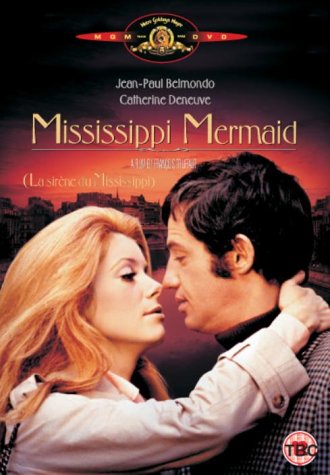I could only find one movie which was set on Réunion Island, François Truffaut's 1969 La sirène du Mississippi (in English, Mississippi Mermaid) starring Catherine Deneuve and Jean-Paul Belmondo.
I've realised I definitely don't know enough about Truffaut and that I need to see more of his movies. His 1959 film Les Quatre Cents Coups (The 400 Blows) was a defining moment in French New Wave cinema and he seems to be a kind of French Hitchcock, telling stories of passion and crime, filled with intensity and romanticism.
La sirène du Mississippi was no exception. It's based on a novel published in 1947 called Waltz into Darkness by the U.S. writer Cornell Woolrich, who wrote under various pseudonyms. Waltz into Darkness was written under the pseudonym William Irish and is a kind of Noir fiction, telling the story of a wealthy man who is duped by a beautiful woman, but he persists in loving her and being duped even more, even if it means he will lose everything.
One of the big themes of the novel and the movie is mundane stability versus momentary pleasure. The wealthy man has a good life and wants for nothing except female company and adventure. When the mermaid appears on the scene, in the guise of a woman answering a lonely hearts column, he can't resist the call and plunges headlong into financial ruin.
 |
| Truffaut's 1969 film La sirène du Mississippi |
Truffaut's choice of Réunion is an interesting one and I couldn't help but wonder why he chose to use the island as his setting for this histoire noir. The first part of the movie gives the viewer a brief overview of Réunion's geography and history, so I thought perhaps Truffaut wanted to increase public knowledge about Réunion in France, perhaps a politically motivated choice?
However, I think the main reason he chose Réunion was because of its exotic location, which gave the story an additional dimension that was quite Gothic in its nature. I've been interested in Gothic fiction for quite some time and a common theme of Gothic literature is an innocent young virgin, held hostage by a wealthy but cruel man in a faraway castle, on a remote mountain top or deep in the forest.
Cornell's novel turns the Gothic theme on its head, as it's the 'not so innocent' and 'not so virgin' young woman who takes advantage of the wealthy man. Whilst Cornell's novel was set in the culturally remote Gothic landscape of New Orleans, Truffaut cleverly uses Réunion as an exotic, faraway, frightening back-drop for the main part of the story.
It was my first time to see the island on film and I thought it looked amazing - gorgeous plantation houses deep in the jungle, Belmondo wearing a see-through white shirt and driving around the island in a 60's car. It's very much a movie of its time and stylish in a way that would be difficult to replicate nowadays.
I also watched the movie en français, but with French subtitles, which definitely increased my enjoyment of the language and the drama, although I did have to pause every now and then, to look something up in my French-English dictionary!
Truffaut also makes references to Blanche-Neige et les septs Nains aka Snow White and the Seven Dwarves - a reference that I'm still mulling over. He also references sources I'd not heard of before, such as Jean Renoir's 1936 movie, Le Crime du Monsieur Lange and Balzac's 1831 novel, La peau du chagrin.
I guess I have a lot more learning to do!
I guess I have a lot more learning to do!

No comments:
Post a Comment